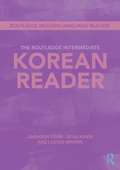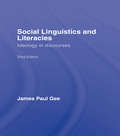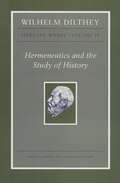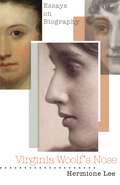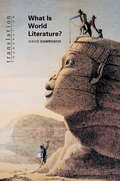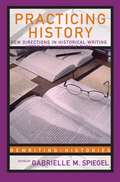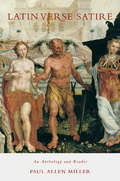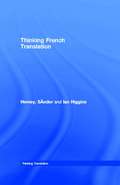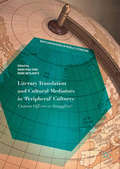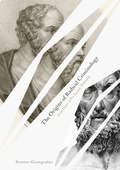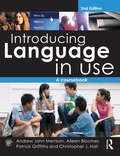- Table View
- List View
The Routlege Intermediate Korean Reader
by Jaehoon Yeon Jieun Kiaer Lucien BrownThe Routledge Intermediate Korean Reader is a comprehensive reader designed to provide varied, stimulating and up-to-date reading material for learners of Korean at the intermediate level. The Korean Reader provides a bridge between basic literacy skills and the ability to read full novels and newspapers in Korean. It consists of eighteen readings, graded on the basis of complexity of vocabulary, grammar and syntax. These readings present a range of different text types representative of modern Korean literary and popular writing which will inspire learners to continue reading independently in Korean. It is ideal for learners who already possess knowledge of essential grammar and vocabulary and who wish to expand their knowledge of the language through contextualized reading material. Key features include: extracts of modern literature and newspaper/magazine articles vocabulary lists for quick reference short grammar explanations of any complicated structures comprehension and discussion questions full answer key at the back. Suitable for both class use and independent study, The Routledge Intermediate Korean Reader is an essential tool for facilitating vocabulary learning and increasing reading proficiency. The Reader is ideal for learners at the intermediate-mid or intermediate high who are aiming to achieve advanced proficiency according to the ACTFL proficiency guidelines. In terms of the Common European Framework this equates to a progression from A2 through to B1/B2.
Social Linguistics and Literacies: Ideology in Discourses
by James GeeThis fully-updated new edition engages with topics such as orality and literacy, the history of literacy, the uses and abuses of literacy in that history, the analysis of language as cultural communication, and social theories of mind and meaning, among many other topics. It represents the most current statement of a widely discussed and used theory about how language functions in society, a theory initially developed in the first edition of the book, and developed in this new edition in tandem with analytic techniques for the study of language and literacy in context, with special reference to cross-cultural issues in communities and schools. Built around a large number of specific examples, this new edition reflects current debates across the world about education and educational reform, the nature of language and communication, and the role of sociocultural diversity in schools and society. One of the core goals of this book, from its first edition on, has been to develop a new and more widely applicable vision of applied linguistics. It will be of interest to researchers, lecturers and students in education, linguistics, or any field that deals with language, especially in social or cultural terms.
The Articulate Mammal: An Introduction to Psycholinguistics
by Jean AitchisonAn established bestseller, The Articulate Mammal is a concise and highly readable introduction to the main topics in psycholinguistics. This fifth edition brings the book up-to-date with recent theories, including new material on: the possibility of a ‘language gene’ post-Chomskyan ideas language within an evolutionary framework spatial cognition and how this affects language how children become acclimatized to speech rhythms before birth the acquisition of verbs construction and cognitive grammar aphasia and dementia. Requiring no prior knowledge of the subject, chapter by chapter, The Articulate Mammal tackles the basic questions central to the study of psycholinguistics. Jean Aitchison investigates these issues with regard to animal communication, child language and the language of adults, and includes in the text full references and helpful suggestions for further reading. The accompanying website to this book can be found at: www.routledge.com/textbooks/9780415420228.
Wilhelm Dilthey: Hermeneutics and the Study of History (PDF)
by Wilhelm Dilthey Frithjof Rodi Rudolf A. MakkreelThe philosopher and historian of culture Wilhelm Dilthey (1833-1911) has had a significant and continuing influence on twentieth-century Continental philosophy and in a broad range of scholarly disciplines. This volume is the third to be published in Princeton University Press's projected six-volume series of his most important works. Part One makes available three of his works on hermeneutics and its history: "Schleiermacher's Hermeneutical System in Relation to Earlier Protestant Hermeneutics" (The Prize Essay of 1860); "On Understanding and Hermeneutics" (1867-68), based on student lecture notes, and the "The Rise of Hermeneutics" (1900), which traces the history of hermeneutics back to Hellenistic Greece. All the addenda to this well-known essay are translated here, some for the first time. In them Dilthey articulates three philosophical aporias concerning hermeneutics and projects an ultimate convergence between understanding and explanation. Part Two provides translations of review essays by Dilthey on Buckle's use of statistical history and on Burckhardt's cultural history; an essay "Friedrich Schlosser and the Problem of Universal History;" and a talk recalling his early years as a student of Boeckh, Jakob Grimm, Mommsen, Ranke, and Ritter. It also contains the important historical essay "The Eighteenth Century and the Historical World," in which Dilthey reexamines the Enlightenment to show its significant contributions to the rise of historical consciousness.
Virginia Woolf's Nose: Essays on Biography (PDF)
by Hermione LeeWhat choices must a biographer make when stitching the pieces of a life into one coherent whole? How do we best create an accurate likeness of a private life from the few articles that linger after death? How do we choose what gets left out? This intriguing and witty collection of essays by an internationally acclaimed biographer looks at how biography deals with myths and legends, what goes missing and what can't be proved in the story of a life. Virginia Woolf's Nose presents a variety of case-studies, in which literary biographers are faced with gaps and absences, unprovable stories and ambiguities surrounding their subjects. By looking at stories about Percy Bysshe Shelley's shriveled, burnt heart found pressed between the pages of a book, Jane Austen's fainting spell, Samuel Pepys's lobsters, and the varied versions of Virginia Woolf's life and death, preeminent biographer Hermione Lee considers how biographers deal with and often utilize these missing body parts, myths, and contested data to "fill in the gaps" of a life story. In "Shelley's Heart and Pepys's Lobsters," an essay dealing with missing parts and biographical legends, Hermione Lee discusses one of the most complicated and emotionally charged examples of the contested use of biographical sources. "Jane Austen Faints" takes five competing versions of the same dramatic moment in the writer's life to ask how biography deals with the private lives of famous women. "Virginia Woolf's Nose" looks at the way this legendary author's life has been translated through successive transformations, from biography to fiction to film, and suggests there can be no such thing as a definitive version of a life. Finally, "How to End It All" analyzes the changing treatment of deathbed scenes in biography to show how biographical conventions have shifted, and asks why the narrators and readers of life-stories feel the need to give special meaning and emphasis to endings. Virginia Woolf's Nose sheds new light on the way biographers bring their subjects to life as physical beings, and offers captivating new insights into the drama of "life-writing". Virginia Woolf's Nose is a witty, eloquent, and funny text by a renowned biographer whose sensitivity to the art of telling a story about a human life is unparalleled--and in creating it, Lee articulates and redefines the parameters of her craft.
What Is World Literature? (Translation/Transnation (PDF))
by David DamroschWorld literature was long defined in North America as an established canon of European masterpieces, but an emerging global perspective has challenged both this European focus and the very category of "the masterpiece." The first book to look broadly at the contemporary scope and purposes of world literature, What Is World Literature? probes the uses and abuses of world literature in a rapidly changing world. In case studies ranging from the Sumerians to the Aztecs and from medieval mysticism to postmodern metafiction, David Damrosch looks at the ways works change as they move from national to global contexts. Presenting world literature not as a canon of texts but as a mode of circulation and of reading, Damrosch argues that world literature is work that gains in translation. When it is effectively presented, a work of world literature moves into an elliptical space created between the source and receiving cultures, shaped by both but circumscribed by neither alone. Established classics and new discoveries alike participate in this mode of circulation, but they can be seriously mishandled in the process. From the rediscovered Epic of Gilgamesh in the nineteenth century to Rigoberta Menchú's writing today, foreign works have often been distorted by the immediate needs of their own editors and translators. Eloquently written, argued largely by example, and replete with insightful close readings, this book is both an essay in definition and a series of cautionary tales.
Practicing History: New Directions in Historical Writing after the Linguistic Turn (Rewriting Histories)
by Gabrielle M. SpiegelThis essential collection of key articles offers a re-evaluation of the practice of history in light of current debates. Critical thinkers and practicing historians present their writings, along with clear and thorough editorial material, to examine the complex ideas at the forefront of historical practice. This volume gives a synoptic overview of the last twenty-five years’ theoretical analysis of historical writing, with a critical examination of the central concepts and positions that have been in debate. The collection delineates the emergence of "practice theory" as a possible paradigm for future historical interpretation concerned with questions of agency, experience and the subject. These complex ideas are introduced to students in this accessible reader, and for teachers and historians too, this survey is an indispensable and timely read.
Practicing History: New Directions in Historical Writing after the Linguistic Turn (Rewriting Histories)
by Gabrielle M. SpiegelThis essential collection of key articles offers a re-evaluation of the practice of history in light of current debates. Critical thinkers and practicing historians present their writings, along with clear and thorough editorial material, to examine the complex ideas at the forefront of historical practice. This volume gives a synoptic overview of the last twenty-five years’ theoretical analysis of historical writing, with a critical examination of the central concepts and positions that have been in debate. The collection delineates the emergence of "practice theory" as a possible paradigm for future historical interpretation concerned with questions of agency, experience and the subject. These complex ideas are introduced to students in this accessible reader, and for teachers and historians too, this survey is an indispensable and timely read.
Latin Verse Satire: An Anthology and Reader
by Paul Allen MillerA wide variety of texts by the Latin satirists are presented here in a fully loaded resource to provide an innovative reading of satire's relation to Roman ideology. Brimming with notes, commentaries, essays and texts in translation, this book succeeds in its mission to help the student understand the history of Latin's modern scholarly reception.Focusing on the linguistic difficulties and problems of usage, and examining aspects of meter and style necessary for poetry appreciation, the commentary places each selection in its own historical context then using essays and critical excerpt, the genre's most salient features are elucidated to provide a further understanding of its place in history.Extremely student friendly, this stands well both as a companion to Latin Erotic Elegy and in its own right as an invaluable fund of knowledge for any Latin literature scholar.
Latin Verse Satire: An Anthology and Reader
by Paul Allen MillerA wide variety of texts by the Latin satirists are presented here in a fully loaded resource to provide an innovative reading of satire's relation to Roman ideology. Brimming with notes, commentaries, essays and texts in translation, this book succeeds in its mission to help the student understand the history of Latin's modern scholarly reception.Focusing on the linguistic difficulties and problems of usage, and examining aspects of meter and style necessary for poetry appreciation, the commentary places each selection in its own historical context then using essays and critical excerpt, the genre's most salient features are elucidated to provide a further understanding of its place in history.Extremely student friendly, this stands well both as a companion to Latin Erotic Elegy and in its own right as an invaluable fund of knowledge for any Latin literature scholar.
The Wheel of Fire: Interpretations Of Shakespearean Tragedy (Routledge Classics)
by G. Wilson KnightOriginally published in 1930, this classic of modern Shakespeare criticism proves both enlightening and innovative. Standing head and shoulders above all other Shakespearean interpretations, Wheel of Fire is the masterwork of the brilliant English scholar G. Wilson Knight. Founding a new and influential school of Shakespearean criticism, Wheel of Fire was Knight's first venture in the field - his writing sparkles with insight and wit, and his analyses are key to contemporary understandings of Shakespeare..
The Wheel of Fire (Routledge Classics)
by G. Wilson KnightOriginally published in 1930, this classic of modern Shakespeare criticism proves both enlightening and innovative. Standing head and shoulders above all other Shakespearean interpretations, Wheel of Fire is the masterwork of the brilliant English scholar G. Wilson Knight. Founding a new and influential school of Shakespearean criticism, Wheel of Fire was Knight's first venture in the field - his writing sparkles with insight and wit, and his analyses are key to contemporary understandings of Shakespeare..
Thinking French Translation: A Course In Translation Method-french To English (Thinking Translation)
by Sándor Hervey Ian HigginsThe new edition of this popular course in translation from French into English offers a challenging practical approach to the acquisition of translation skills, with clear explanations of the theoretical issues involved. A variety of translation issues are considered including:*cultural differences*register and dialect*genre*revision and editing.The course now covers texts from a wide range of sources, including:*journalism and literature*commercial, legal and technical texts*songs and recorded interviews.This is essential reading for advanced undergraduates and postgraduate students of French on translation courses. The book will also appeal to wide range of language students and tutors.
Thinking French Translation (Thinking Translation)
by Sándor Hervey Ian HigginsThe new edition of this popular course in translation from French into English offers a challenging practical approach to the acquisition of translation skills, with clear explanations of the theoretical issues involved. A variety of translation issues are considered including:*cultural differences*register and dialect*genre*revision and editing.The course now covers texts from a wide range of sources, including:*journalism and literature*commercial, legal and technical texts*songs and recorded interviews.This is essential reading for advanced undergraduates and postgraduate students of French on translation courses. The book will also appeal to wide range of language students and tutors.
Literary Translation and Cultural Mediators in 'Peripheral' Cultures: Customs Officers or Smugglers? (New Comparisons in World Literature)
by Diana Roig-Sanz Reine MeylaertsThis book sets the grounds for a new approach exploring cultural mediators as key figures in literary and cultural history. It proposes an innovative conceptual and methodological understanding of the figure of the cultural mediator, defined as a cultural actor active across linguistic, cultural and geographical borders, occupying strategic positions within large networks and being the carrier of cultural transfer. Many studies on translation and cultural mediation privileged the major metropolis of Paris, London, and New York as centres of cultural production and translation. However, other cities and megacities that are not global centres of culture also feature vibrant translation scenes. This book abandons the focus on ‘innovative’ centres and ‘imitative’ peripheries and follows processes of cultural exchange as they develop. Thus, it analyses the role of cultural mediators as customs officers or smugglers (or both in different proportions) in so-called ‘peripheral’ cultures and offers insights into an under-analysed body of actors and institutions promoting intercultural transfer in often multilingual and less studied venues such as Trieste, Tel Aviv, Buenos Aires, Lima, Lahore, or Cape Town.
The Portable Bunyan: A Transnational History of The Pilgrim's Progress (PDF)
by Isabel HofmeyrHow does a book become an international bestseller? What happens to it as it is translated into different languages, contexts, and societies? How is it changed by the intellectual environments it encounters? What does the transnational circulation mean for its reception back home? Exploring the international life of a particularly long-lived and widely traveled book, Isabel Hofmeyr follows The Pilgrim's Progress as it circulates through multiple contexts--and into some 200 languages--focusing on Africa, where 80 of the translations occurred. This feat of literary history is based on intensive research that criss-crossed among London, Georgia, Kingston, Bedford (John Bunyan's hometown), and much of sub-Saharan Africa. Finely written and unusually wide-ranging, it accounts for how The Pilgrim's Progress traveled abroad with the Protestant mission movement, was adapted and reworked by the societies into which it traveled, and, finally, how its circulation throughout the empire affected Bunyan's standing back in England. The result is a new intellectual approach to Bunyan--one that weaves together British, African, and Caribbean history with literary and translation studies and debates over African Christianity and mission. Even more important, this book is a rare example of a truly worldly study of "world literature"--and of the critical importance of translation, both linguistic and cultural.
Literary Translation and Cultural Mediators in 'Peripheral' Cultures: Customs Officers or Smugglers? (New Comparisons in World Literature)
by Diana Roig-Sanz Reine MeylaertsThis book sets the grounds for a new approach exploring cultural mediators as key figures in literary and cultural history. It proposes an innovative conceptual and methodological understanding of the figure of the cultural mediator, defined as a cultural actor active across linguistic, cultural and geographical borders, occupying strategic positions within large networks and being the carrier of cultural transfer. Many studies on translation and cultural mediation privileged the major metropolis of Paris, London, and New York as centres of cultural production and translation. However, other cities and megacities that are not global centres of culture also feature vibrant translation scenes. This book abandons the focus on ‘innovative’ centres and ‘imitative’ peripheries and follows processes of cultural exchange as they develop. Thus, it analyses the role of cultural mediators as customs officers or smugglers (or both in different proportions) in so-called ‘peripheral’ cultures and offers insights into an under-analysed body of actors and institutions promoting intercultural transfer in often multilingual and less studied venues such as Trieste, Tel Aviv, Buenos Aires, Lima, Lahore, or Cape Town.
The Origins of Radical Criminology: From Homer to Pre-Socratic Philosophy
by Stratos GeorgoulasThis book critically explores the development of radical criminology through a range of written Ancient Greek works including epic and lyrical poetry, drama and philosophy, across different chapters. It traces the development of political power and the concepts of law, legitimacy, crime, justice and deviance in the Ancient Greek world and the political struggles that propelled that development, using the conflict perspective as a conceptual tool of the sociological analysis of reality. Theoretical discussions of crime and justice typically stem from the better known works of Plato or Aristotle although this book explores the works preceding these. This book will appeal to those interested in the (pre)history of criminology and the historical production of criminological knowledge.
The Origins of Radical Criminology: From Homer to Pre-Socratic Philosophy
by Stratos GeorgoulasThis book critically explores the development of radical criminology through a range of written Ancient Greek works including epic and lyrical poetry, drama and philosophy, across different chapters. It traces the development of political power and the concepts of law, legitimacy, crime, justice and deviance in the Ancient Greek world and the political struggles that propelled that development, using the conflict perspective as a conceptual tool of the sociological analysis of reality. Theoretical discussions of crime and justice typically stem from the better known works of Plato or Aristotle although this book explores the works preceding these. This book will appeal to those interested in the (pre)history of criminology and the historical production of criminological knowledge.
Understanding Morphology (Understanding Language)
by Martin Haspelmath Andrea SimsThis new edition of Understanding Morphology has been fully revised in line with the latest research. It now includes 'big picture' questions to highlight central themes in morphology, as well as research exercises for each chapter. Understanding Morphology presents an introduction to the study of word structure that starts at the very beginning. Assuming no knowledge of the field of morphology on the part of the reader, the book presents a broad range of morphological phenomena from a wide variety of languages. Starting with the core areas of inflection and derivation, the book presents the interfaces between morphology and syntax and between morphology and phonology. The synchronic study of word structure is covered, as are the phenomena of diachronic change, such as analogy and grammaticalization. Theories are presented clearly in accessible language with the main purpose of shedding light on the data, rather than as a goal in themselves. The authors consistently draw on the best research available, thus utilizing and discussing both functionalist and generative theoretical approaches. Each chapter includes a summary, suggestions for further reading, and exercises. As such this is the ideal book for both beginning students of linguistics, or anyone in a related discipline looking for a first introduction to morphology.
An Introduction to Applied Linguistics (A hodder Arnold Publication)
by Norbert SchmittAn Introduction to Applied Linguistics, Second Edition provides a complete, authoritative and up-to-date overview of the state of the field. Each of the 15 chapters offers an extended survey of a central element of Applied Linguistics and is co-authored by two leading international specialists, thus ensuring a full and balanced treatment of the topic covered. The book is divided into three sections: a description of language and language use; essential areas of enquiry; and the four skills and testing. An Introductory chapter familiarises readers with key issues and recurrent themes whilst hands-on activities and further reading sections for each chapter encourage practical analysis and wider reading. For this new edition, each chapter has been fully revised in line with new research and thinking in Applied Linguistics. With its accessible style, broad coverage and practical focus, this book is ideal for students of applied linguistics, TESOL, and second language pedagogy as well as practicing teachers and researchers wishing to update their knowledge.
Introducing Language in Use: A Course Book
by Andrew John Merrison Aileen Bloomer Patrick Griffiths Christopher J. HallIntroducing Language in Use, second edition, provides a lively and accessible introduction to the study of language and linguistics. Drawing on a vast range of data and examples of language in its many forms, this book provides students with the tools they need to analyse real language in diverse contexts. The second edition of this best-selling textbook has been fully revised and updated with entirely new chapters on Phonology and Sociolinguistics, two separate chapters on syntax and grammar, completely rewritten chapters on Multilingualism, Psycholinguistics and World Englishes, and a greater focus on corpus linguistics. Introducing Language in Use: covers all the core areas and topics of language study, including semiotics, communication, grammar, phonetics, phonology, words, semantics, variety in language, history of English, world Englishes, multilingualism, psycholinguistics, sociolinguistics, language acquisition, conversation analysis, pragmatics and politeness adopts a 'how to' approach, encouraging students to apply their knowledge as they learn it draws on examples of language from around the world in forms ranging from conversation to advertising and text messaging, always giving precedence to real language in use includes activities throughout the text and an extensive glossary of terms The book is supported by a companion website offering a wealth of additional resources including commentaries on the activities in the book, suggested further reading and references, links to useful websites, more texts to analyse, additional web activities, ‘fun with language’ exercises, discussion questions and an additional ‘Language in Education’ chapter. This is an essential coursebook for all introductory courses in English language, communication and linguistics. Visit the companion website at www.routledge.com/cw/merrison
Introducing Language in Use: A Course Book
by Andrew John Merrison Aileen Bloomer Patrick Griffiths Christopher J. HallIntroducing Language in Use, second edition, provides a lively and accessible introduction to the study of language and linguistics. Drawing on a vast range of data and examples of language in its many forms, this book provides students with the tools they need to analyse real language in diverse contexts. The second edition of this best-selling textbook has been fully revised and updated with entirely new chapters on Phonology and Sociolinguistics, two separate chapters on syntax and grammar, completely rewritten chapters on Multilingualism, Psycholinguistics and World Englishes, and a greater focus on corpus linguistics. Introducing Language in Use: covers all the core areas and topics of language study, including semiotics, communication, grammar, phonetics, phonology, words, semantics, variety in language, history of English, world Englishes, multilingualism, psycholinguistics, sociolinguistics, language acquisition, conversation analysis, pragmatics and politeness adopts a 'how to' approach, encouraging students to apply their knowledge as they learn it draws on examples of language from around the world in forms ranging from conversation to advertising and text messaging, always giving precedence to real language in use includes activities throughout the text and an extensive glossary of terms The book is supported by a companion website offering a wealth of additional resources including commentaries on the activities in the book, suggested further reading and references, links to useful websites, more texts to analyse, additional web activities, ‘fun with language’ exercises, discussion questions and an additional ‘Language in Education’ chapter. This is an essential coursebook for all introductory courses in English language, communication and linguistics. Visit the companion website at www.routledge.com/cw/merrison
Doing Pragmatics
by Peter GrundyDoing Pragmatics achieved success through its unparalleled capacity to render pragmatics truly accessible to students. Embracing the comprehensive and engaging style which characterised the previous editions, the third edition is fully revised and expanded. Grundy consolidates the strengths of the original version, reinforcing its unique combination of theory and practice with new theory, exercises and up-to-date, real data and examples. New chapters include pragmatic inference and language evolution, and intercultural pragmatics. Doing Pragmatics is designed for pragmatics courses both at an introductory and a more advanced level. It extends beyond theory to promote an applied understanding of empirical data and to provide students with the opportunity to 'do' pragmatics themselves, providing the ideal foundation for all those studying linguistics and ELT.
English Accents and Dialects: An Introduction to Social and Regional Varieties of English in the British Isles, Fifth Edition (The English Language Series)
by Arthur Hughes Peter Trudgill Dominic WattEnglish Accents and Dialects is an essential guide to contemporary social and regional varieties of English spoken in the British Isles today. Together with invaluable overviews of numerous regional accents and dialects, this fifth edition provides a detailed description of key features of Received Pronounciation (RP) as well as several major non-standard varieties of English.Key features: main regional differences are followed by a survey of speech in over 20 areas of the UK and Ireland, audio samples of which are available to download at www.routledge.com/cw/hughes recent findings on London English, Aberdeen English and Liverpool English contains new entries on Hull, Manchester, Carlisle, Middlesbrough, Southampton, London West Indian, Lancashire and the Shetlands additional exercises with answers online accompany the new varieties clear maps throughout for locating particular accents and dialects. This combination of reference manual and practical guide makes this fifth edition of English Accents and Dialects a highly useful resource providing a comprehensive and contemporary coverage of speech in the UK and Ireland today.
